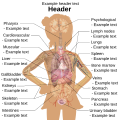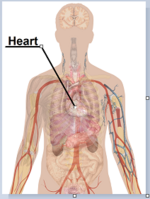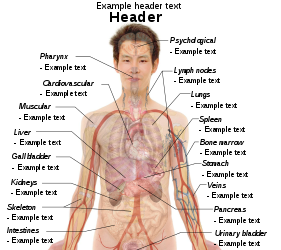File:Girl diagram template.svg

Original file (SVG file, nominally 2,972 × 2,986 pixels, file size: 3.02 MB)
Captions
Captions
Contents
Summary
edit| DescriptionGirl diagram template.svg |
English: Template for use in Inkscape to make diagrams Further information: Human body diagrams.
To discuss image, please see Template talk:Human body diagrams |
| Date | |
| Source |
All used images are in public domain.
 |
| Author | Mikael Häggström |
| SVG development InfoField | This diagram was created with Inkscape. This diagram uses embedded text that can be easily translated using a text editor. This SVG diagram uses required raster graphics to show delicate structures. |
Licensing
edit| Public domainPublic domainfalsefalse |
| I, the copyright holder of this work, release this work into the public domain. This applies worldwide. In some countries this may not be legally possible; if so: I grant anyone the right to use this work for any purpose, without any conditions, unless such conditions are required by law. |
Human body diagramseditMain article at: Human body diagrams Template location:Template:Human body diagrams How to derive an imageeditDerive directly from raster image with organseditThe raster (.png format) images below have most commonly used organs already included, and text and lines can be added in almost any graphics editor. This is the easiest method, but does not leave any room for customizing what organs are shown. Adding text and lines: Derive "from scratch"editBy this method, body diagrams can be derived by pasting organs into one of the "plain" body images shown below. This method requires a graphics editor that can handle transparent images, in order to avoid white squares around the organs when pasting onto the body image. Pictures of organs are found on the project's main page. These were originally adapted to fit the male shadow/silhouette.
Organs:
Derive by vector templateeditThe Vector templates below can be used to derive images with, for example, Inkscape. This is the method with the greatest potential. See Human body diagrams/Inkscape tutorial for a basic description in how to do this.
Examples of derived worksedit
Licensingedit
|
File history
Click on a date/time to view the file as it appeared at that time.
| Date/Time | Thumbnail | Dimensions | User | Comment | |
|---|---|---|---|---|---|
| current | 21:05, 1 February 2019 |  | 2,972 × 2,986 (3.02 MB) | Mikael Häggström (talk | contribs) | +Eyes |
| 19:36, 19 January 2018 |  | 2,972 × 2,986 (2.84 MB) | Mikael Häggström (talk | contribs) | Italics | |
| 19:33, 19 January 2018 |  | 2,972 × 2,986 (2.84 MB) | Mikael Häggström (talk | contribs) | Text adjustment | |
| 18:55, 19 January 2018 |  | 2,342 × 3,042 (2.83 MB) | Mikael Häggström (talk | contribs) | User created page with UploadWizard |
You cannot overwrite this file.
File usage on Commons
More than 100 pages use this file. The following list shows the first 100 pages that use this file only. A full list is available.
- Human body diagrams
- File:Bacterial infections and involved species.png
- File:Bacterial infections and involved species.svg
- File:Bodily effects of cannabis.png
- File:Bodily effects of cannabis.svg
- File:Chemical basis of love.png
- File:Chemical basis of love.svg
- File:Effects of Salvia Divinorum.png
- File:Effects of Salvia Divinorum.svg
- File:Effects of metamphetamine.png
- File:Effects of metamphetamine.svg
- File:Energy and life.png
- File:Energy and life.svg
- File:Extrapulmonary tuberculosis symptoms.png
- File:Health benefits of apples.png
- File:Health benefits of apples.svg
- File:Health benefits of bananas.png
- File:Health benefits of bananas.svg
- File:Health effects of pollution.png
- File:Health effects of pollution.svg
- File:Long-term effects of heroin.png
- File:Long-term effects of heroin.svg
- File:Main complications of persistent high blood pressure.png
- File:Main complications of persistent high blood pressure.svg
- File:Main side effects of Caffeine.png
- File:Main side effects of Caffeine.svg
- File:Main symptoms of Caffeine overdose.png
- File:Main symptoms of Caffeine overdose.svg
- File:Main symptoms of Hydrocodone overdose.png
- File:Main symptoms of Hydrocodone overdose.svg
- File:Main symptoms of Infectious mononucleosis.png
- File:Main symptoms of Infectious mononucleosis.svg
- File:Main symptoms of acute hemolytic reaction.png
- File:Main symptoms of acute hemolytic reaction.svg
- File:Main symptoms of carbon dioxide toxicity.png
- File:Main symptoms of carbon dioxide toxicity.svg
- File:Main symptoms of copper poisoning.png
- File:Main symptoms of copper poisoning.svg
- File:Main symptoms of diabetes.png
- File:Main symptoms of diabetes.svg
- File:Main symptoms of hydrogen toxicity.png
- File:Main symptoms of hydrogen toxicity.svg
- File:Main symptoms of infectious pneumonia.png
- File:Physiological effects of Crack cocaine.png
- File:Physiological effects of Crack cocaine.svg
- File:Possible long-term effects of ethanol.png
- File:Possible long-term effects of ethanol.svg
- File:Possible physical effects of lysergic acid diethylamide (LSD).png
- File:Possible physical effects of lysergic acid diethylamide (LSD).svg
- File:Pulmonary tuberculosis symptoms.png
- File:Short-term effects of heroin.png
- File:Short-term effects of heroin.svg
- File:Side effects of Hydrocodone.png
- File:Side effects of Hydrocodone.svg
- File:Side effects of Oxycodone.png
- File:Side effects of Oxycodone.svg
- File:Side effects of Tramadol.png
- File:Side effects of Tramadol.svg
- File:Side effects of Vicodin.png
- File:Side effects of Vicodin.svg
- File:Side effects of chronic use of Cocaine.png
- File:Side effects of chronic use of Cocaine.svg
- File:Snake bite symptoms.png
- File:Snake bite symptoms.svg
- File:Stem cell treatments.png
- File:Stem cell treatments.svg
- File:Surface anatomy of the heart.png
- File:Surface anatomy of the heart.svg
- File:Symptoms of AIDS.png
- File:Symptoms of AIDS.svg
- File:Symptoms of Malaria.png
- File:Symptoms of Malaria.svg
- File:Symptoms of Meningitis.png
- File:Symptoms of Meningitis.svg
- File:Symptoms of Raw fish infection.png
- File:Symptoms of Raw fish infection.svg
- File:Symptoms of Spider bite.png
- File:Symptoms of acidosis.png
- File:Symptoms of acidosis.svg
- File:Symptoms of acute HIV infection.png
- File:Symptoms of acute HIV infection.svg
- File:Symptoms of anemia.png
- File:Symptoms of anemia.svg
- File:Symptoms of bubonic plague.png
- File:Symptoms of cancer metastasis.png
- File:Symptoms of fibromyalgia.png
- File:Symptoms of fibromyalgia.svg
- File:Symptoms of gold toxicity.png
- File:Symptoms of gold toxicity.svg
- File:Symptoms of multiple sclerosis.png
- File:Symptoms of multiple sclerosis.svg
- File:Symptoms of oxygen toxicity.png
- File:Symptoms of oxygen toxicity.svg
- File:Symptoms of pneumonia.svg
- File:Symptoms of pneumonic plague.png
- File:Symptoms of spider bite.svg
- File:Symptoms of swine flu-ca.svg
- File:Symptoms of swine flu.png
- File:Symptoms of swine flu.svg
- File:Viral infections and involved species.png
View more links to this file.
Metadata
This file contains additional information such as Exif metadata which may have been added by the digital camera, scanner, or software program used to create or digitize it. If the file has been modified from its original state, some details such as the timestamp may not fully reflect those of the original file. The timestamp is only as accurate as the clock in the camera, and it may be completely wrong.
| Width | 2971.6594 |
|---|---|
| Height | 2986 |





























